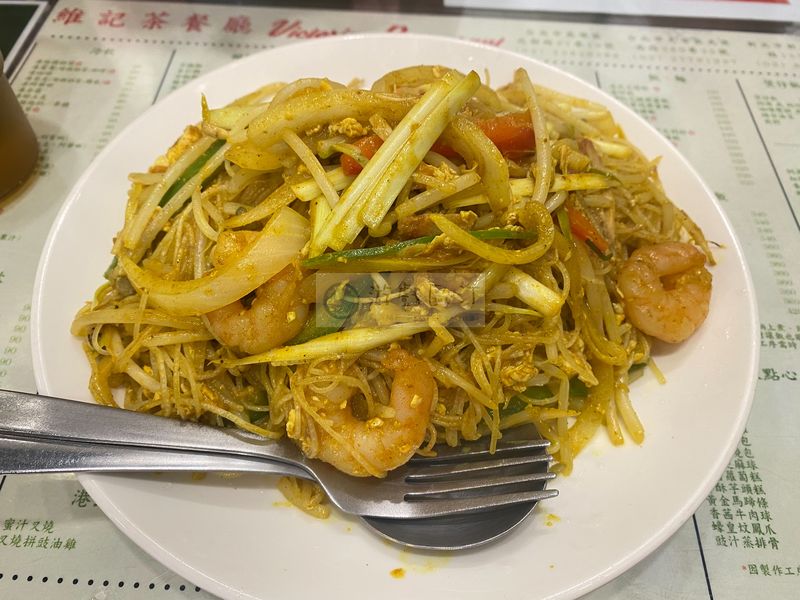新加坡菜餚:星洲炒米
2024-10-09
星洲炒米是以咖喱粉為特色的炒米粉菜餚,最初源自新加坡,但如今在廣東菜系和港式茶餐廳中也十分常見。雖然帶有「星洲」(新加坡的舊稱),但在新加坡本地並不常見,更多的是香港等地的餐廳改良出來的一道風味炒粉。亮點在於色彩繽紛,口感豐富,並且具備濃郁的咖喱香氣。
主要食材包括米粉、咖喱粉、雞蛋、蝦仁、叉燒、綠豆芽、青椒和洋蔥等。這些材料搭配得當,使得整道菜呈現出豐富的層次感與香氣。它的炒製過程要求快速高溫,保證食材不會過熟,並且炒出乾爽而不油膩的口感。
製作的第一步是準備米粉。通常選用細米粉,先用溫水浸泡至軟化,大約需要10到15分鐘。泡軟後的米粉需要瀝乾,這樣在炒的過程中不會過濕,能炒出乾爽的效果。接下來是準備其他食材。叉燒切成細條,蝦仁洗淨並用少許鹽與胡椒粉調味,青椒、洋蔥切絲,豆芽洗淨瀝乾備用。雞蛋則打散,稍微煎成蛋皮,然後切成絲狀。炒製過程中,先將蝦仁用熱油快速炒至變色,然後盛出備用。再在鍋中加少量油,加入洋蔥和青椒絲,翻炒至洋蔥變軟,並開始釋放香氣。這時可以加入咖喱粉翻炒,讓香味散發出來,並與洋蔥、青椒充分融合。
隨後,加入瀝乾的米粉,繼續大火翻炒。這是關鍵的一步,因為米粉很容易因為水分不足或過多而炒得太乾或太濕,所以在這個過程中需要保持米粉的鬆散,並不斷攪拌,確保每根米粉都能均勻裹上咖喱粉和其他食材的香氣。接著,將炒好的蝦仁、叉燒條和蛋絲一併加入鍋中,快速拌炒均勻。最後,加入綠豆芽,翻炒幾下後關火。豆芽只需輕炒保持脆嫩感,不宜過熟。最後的調味非常簡單,一般只需加些鹽、少量的糖提味即可。有時也會加入些許蠔油或醬油,根據個人口味調整。完成後的星洲炒米色彩鮮豔,金黃色的米粉裹著咖喱香,配上鮮嫩的蝦仁、叉燒的甜香、以及清脆的蔬菜,口感豐富多層次。
主要的精髓在於咖喱粉與各種食材的搭配,炒製過程中的火候掌握也很重要,需要快速翻炒、保證食材鮮嫩、米粉乾爽,才能呈現出這道經典美味
。
Singapore-style fried rice vermicelli, known for its distinctive use of curry powder, is a stir-fried noodle dish that originated in Singapore. However, it has become more common in Cantonese cuisine and Hong Kong-style tea restaurants. Despite its name "Singapore," this dish is not widely seen in Singapore itself but is instead a local adaptation found in restaurants in places like Hong Kong. The dish stands out for its vibrant colors, rich textures, and strong curry aroma.
The main ingredients include rice vermicelli, curry powder, eggs, shrimp, char siu (roast pork), mung bean sprouts, bell peppers, and onions. These ingredients are carefully combined to give the dish layers of flavor and aroma. The stir-frying process requires high heat and quick action to ensure that the ingredients do not overcook and that the dish remains dry and not greasy.
The first step in preparation is to soften the rice vermicelli. Typically, thin rice vermicelli is used, soaked in warm water for about 10 to 15 minutes until soft. Once softened, the vermicelli needs to be drained to avoid excess moisture during stir-frying, ensuring the final dish has a dry texture.
Next, other ingredients are prepared. The char siu is cut into thin strips, the shrimp is cleaned and lightly seasoned with salt and pepper, while the bell peppers and onions are sliced. The bean sprouts are washed and drained. The eggs are beaten and lightly fried into a thin omelette, then sliced into strips.
During the stir-frying process, shrimp is first quickly stir-fried in hot oil until it changes color and then set aside. A small amount of oil is then added to the pan, and the onions and bell pepper slices are sautéed until the onions soften and release their aroma. At this point, curry powder is added and stir-fried to release its fragrance and combine with the onions and bell peppers.
Next, the drained rice vermicelli is added to the pan and stir-fried over high heat. This is a critical step, as the vermicelli can easily become too dry or too wet. The key is to keep the noodles loose and stir constantly, ensuring each strand is evenly coated with curry powder and the aromas of the other ingredients.
Afterward, the cooked shrimp, char siu strips, and egg strips are added back to the pan, and everything is stir-fried together. Lastly, mung bean sprouts are tossed in and stir-fried briefly before turning off the heat. The sprouts should remain crisp and tender, so they are not overcooked.
The final seasoning is simple—usually just a bit of salt and a small amount of sugar to enhance the flavor. Sometimes, a dash of oyster sauce or soy sauce is added, depending on personal taste. Once done, the Singapore-style fried rice vermicelli boasts bright colors, with golden noodles infused with curry flavor, complemented by tender shrimp, the sweet aroma of char siu, and the crispness of vegetables, creating a dish full of rich and layered textures.
The essence of this dish lies in the combination of curry powder and the various ingredients. Mastery of the stir-frying technique is also crucial, requiring quick, high-heat stir-frying to keep the ingredients fresh and the noodles dry, resulting in this classic and flavorful dish.

- 1
- 2
- 3
- 4
